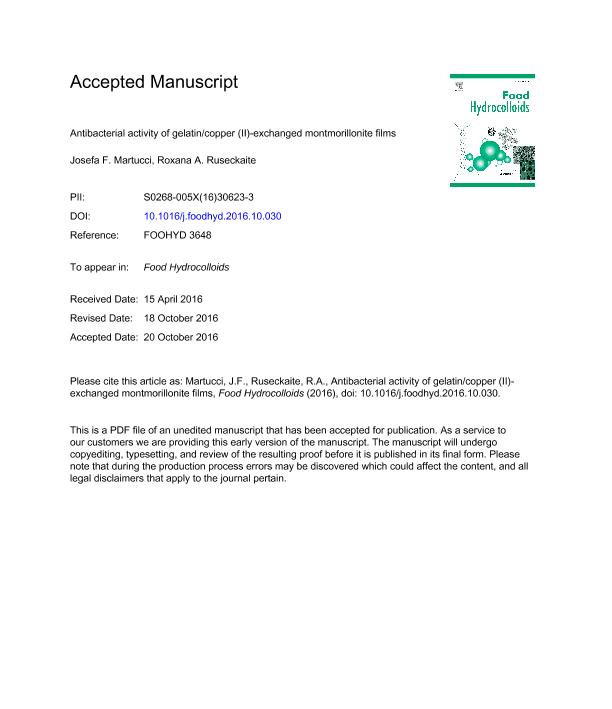Mostrar el registro sencillo del ítem
dc.contributor.author
Martucci, Josefa Fabiana

dc.contributor.author
Ruseckaite, Roxana Alejandra

dc.date.available
2018-01-08T19:12:59Z
dc.date.issued
2016-10-21
dc.identifier.citation
Martucci, Josefa Fabiana; Ruseckaite, Roxana Alejandra; Antibacterial activity of gelatin/copper (II)-exchanged montmorillonite films; Elsevier; Food Hydrocolloids; 64; 21-10-2016; 70-77
dc.identifier.issn
0268-005X
dc.identifier.uri
http://hdl.handle.net/11336/32561
dc.description.abstract
Cu (II) - exchanged montmorillonite (Cu2+MMt) was prepared, characterized and introduced into a bovine gelatin (Ge) matrix via a dissolution-intercalation method to get antibacterial nanocomposite films. The maximum amount of exchanged cation did not exceed the cation exchange capacity of the pristine montmorillonite (Na+MMt), as assessed by energy dispersive X-ray (EDX) spectroscopy. Cu2+MMt showed antibacterial activity in vitro against Escherichia coli O157:H7 (Gram-negative) and Listeria monocytogenes (Gram-positive) as revealed by the agar disc-diffusion assay. The dispersion of clays in Ge films was monitored by X-ray diffraction (XRD) and Scanning Electron Microscopy (SEM). Blending gelatin with 5% w/w of clay increased the tensile strength of the nanocomposite films in around 280% while the elongation at break and the water vapor permeability decreased in about 42 and 30%, respectively, regardless of the cation in clay. The Ge/Cu2+MMt film exhibited antibacterial effectiveness against both pathogens tested under the same conditions, demonstrating a stronger effect on L. monocytogenes than on E. coli O157:H7, since the cell wall of the latter differs significantly and such difference could influence their vulnerability and response to the active films. Therefore, the incorporation of low clay levels as a vehicle for copper ions into gelatin matrix has demonstrated to be a good method for developing functional materials that can be potentially applied to the design of food contact items.
dc.format
application/pdf
dc.language.iso
eng
dc.publisher
Elsevier

dc.rights
info:eu-repo/semantics/openAccess
dc.rights.uri
https://creativecommons.org/licenses/by-nc-sa/2.5/ar/
dc.subject
Bovine Gelatin
dc.subject
Cupric Ions
dc.subject
Montmorillonite
dc.subject
Nanocomposite
dc.subject
Active Film
dc.subject
Antimicrobial Activity
dc.subject.classification
Recubrimientos y Películas

dc.subject.classification
Ingeniería de los Materiales

dc.subject.classification
INGENIERÍAS Y TECNOLOGÍAS

dc.subject.classification
Ingeniería de los Materiales

dc.subject.classification
Ingeniería de los Materiales

dc.subject.classification
INGENIERÍAS Y TECNOLOGÍAS

dc.title
Antibacterial activity of gelatin/copper (II)-exchanged montmorillonite films
dc.type
info:eu-repo/semantics/article
dc.type
info:ar-repo/semantics/artículo
dc.type
info:eu-repo/semantics/publishedVersion
dc.date.updated
2017-12-12T19:56:15Z
dc.journal.volume
64
dc.journal.pagination
70-77
dc.journal.pais
Países Bajos

dc.journal.ciudad
Amsterdam
dc.description.fil
Fil: Martucci, Josefa Fabiana. Consejo Nacional de Investigaciones Científicas y Técnicas. Centro Científico Tecnológico Conicet - Mar del Plata. Instituto de Investigaciones en Ciencia y Tecnología de Materiales. Universidad Nacional de Mar del Plata. Facultad de Ingeniería. Instituto de Investigaciones en Ciencia y Tecnología de Materiales; Argentina
dc.description.fil
Fil: Ruseckaite, Roxana Alejandra. Consejo Nacional de Investigaciones Científicas y Técnicas. Centro Científico Tecnológico Conicet - Mar del Plata. Instituto de Investigaciones en Ciencia y Tecnología de Materiales. Universidad Nacional de Mar del Plata. Facultad de Ingeniería. Instituto de Investigaciones en Ciencia y Tecnología de Materiales; Argentina
dc.journal.title
Food Hydrocolloids

dc.relation.alternativeid
info:eu-repo/semantics/altIdentifier/url/https://www.sciencedirect.com/science/article/pii/S0268005X16306233
dc.relation.alternativeid
info:eu-repo/semantics/altIdentifier/doi/http://dx.doi.org/10.1016/j.foodhyd.2016.10.030
Archivos asociados
